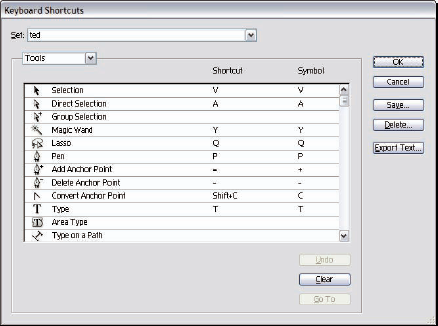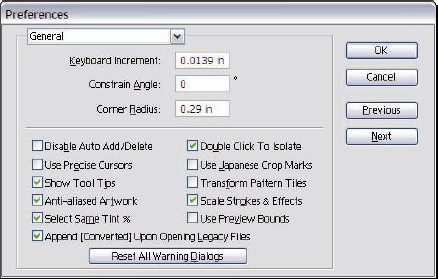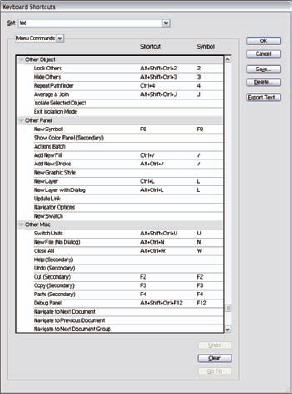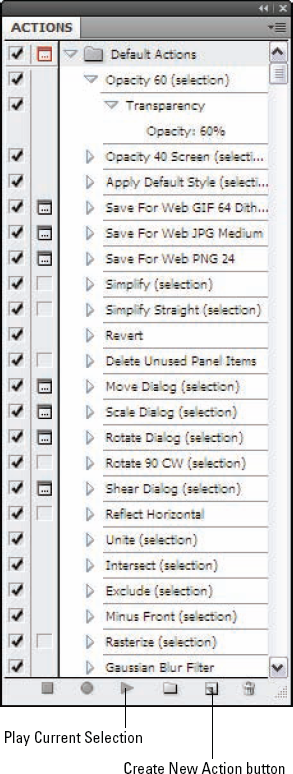In This Chapter
Telling panels where to go
Setting up custom keyboard shortcuts
Getting easier access to tools
Changing the start-up documents
Tweaking the default settings
Editing preferences
Creating Actions
Keyboard commands are great shortcuts — you gotta love 'em, finger cramps and all — but what if you could make them easier to use? Or maybe you have some styles that you use all the time and you want them to be (gasp) available all the time. And how about that quirky default page size that each new document shows up wearing? Well, if you itch to tinker, adjust, and fine-tune (but you misplaced your ball-peen hammer), you came to the right place. This chapter shows you how to adjust, redefine, and yes, customize the way Illustrator works for you.
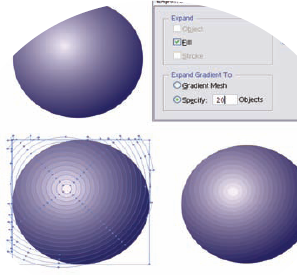
Warning
Before you go on a feature-tweaking rampage, consider this: You're changing how Illustrator works globally. So a word to the wise: Read first. Then, if you like what you see, make a change and try it out for a while before you change anything else. Return to default settings if you make a mistake.
Illustrator saves all panel positions just as they were when you quit Illustrator. The next time you use Illustrator, the panels appear right where you left them. This structure is handy most of the time, but your panels can get a bit disorganized if you move them all over the place while chasing a creative inspiration. If you want to get them back to Square One with no fuss, read on.
You can save a set or sets of panel positions for later use by saving a Workspace, located at Window
Give each tool in the Tools panel its own keyboard shortcut. For example, pressing the V key brings up the Selection tool, and pressing the Z key brings up the Zoom tool.
Note
To change the keyboard shortcut for a tool (or to add shortcuts for tools that don't have any), choose Edit
If the shortcut has been assigned to another command, you'll see a warning message that there's a conflict, what the conflict is, and you'll have the ability to undo your proposed change at that time.
You can customize keyboard shortcuts to all Illustrator menu commands by using the Keyboard Shortcuts dialog box (refer to Figure 18-1). Go to this dialog box by choosing Edit
You can redefine even the most common commands, such as Open and New, with different keyboard shortcuts. To add a new keyboard shortcut, follow these steps:
Choose Edit

The Keyboard Shortcuts dialog box opens.
Choose Menu Commands from the drop-down menu at the top left of the dialog box (the default name is Tools).
A list of all Illustrator menus appears. Click the arrow beside the menu name to open the complete list of items under that menu. If the item already has a keyboard shortcut, you find it listed to the right of the menu item, in the Shortcut column.
Change the keyboard shortcuts by highlighting the current keyboard shortcut, typing a new shortcut, and pressing Enter.
Note
If the item has no keyboard shortcut assigned to it, you can give it one. To highlight the empty space, click in the Shortcut column (to the right of the menu item) and type in your shortcut there.
You can also print out a big sheet of all the keyboard shortcuts, even if you haven't changed any of them. To print out all the keyboard shortcuts, follow these steps:
Choose Edit

The Keyboard Shortcuts dialog box opens.
Click the Export Text button at the middle right of the Keyboard Shortcuts dialog box.
A Save dialog box opens.
Name the text file that you want to contain your keyboard shortcuts, specify a location for it on your hard drive, and then click OK to save the text file.
Open any word processing program on your computer, choose File

Tip
You can always return to the original keyboard commands by choosing Illustrator Defaults from the Set drop-down menu in the upper-left corner of the Keyboard Shortcuts dialog box.
You can change how the entire Illustrator application works. Assuming that you have a plan (handy to have at a time like this), choose Illustrator (icon)
The General tab of the Preferences dialog box is just the first of several Preferences tabs containing a multitude of options for you to change. Each change affects how that the application works, and Illustrator saves these changes when you quit the program, regardless of the documents that you're working in.
Warning
Don't start changing preference settings all helter-skelter when you first stumble across this dialog box. Doing so might cause unexpected behaviors in the application, such as Illustrator printing your letterhead in hieroglyphics. A better idea is to look at the list of items and change only one at a time, testing each item after you change it, even writing down what you did so you can remember the changes. If the results of a change aren't up to snuff, then be sure to change the preference back to its original setting.
Changing Hidden Commands You Never Knew About
In addition to those nice, respectable, visible menu commands and tool shortcuts, all sorts of nifty shortcuts just hang around in Illustrator without a single menu item or tool associated with them. These shortcuts are handy commands, such as Increase Type Size: Ctrl+Shift (Windows)/
Have you ever found yourself doing things again and again (such as typing the word redundant dozens of times)? Have you ever wished that your computer could do some of this tedious work for you? Well, that's where Actions come in. Actions make Illustrator do the grunt work while you get to do all the fun stuff.
Illustrator comes with hundreds of Actions although only a dozen are installed with the software. You can find the rest on your Illustrator application CD-ROM, which you'll have to insert and copy after you install. Better yet, you can make your own Actions! Actions can be virtually any series of Illustrator activities, such as scaling, rotating, changing colors, or bringing selections to the front. You can even use Actions to select objects if they have specific names.
Tip
One of the handiest uses for Actions is creating compound keyboard shortcuts. For example, you can perform a set of procedures at the same time — such as Create New Layer, Place, and Scale — without even wrenching your wrist. Instead of performing all three keyboard commands individually, you can easily set up an Action to do all three simultaneously. Result: One keyboard command does three tasks! You just smile and watch. Choose Window
To use any Action, click it in the Actions panel and then click the Play Current Selection button (the right-pointing arrow) at the bottom of the panel.
Creating your own Action feels something like taping your voice or image and then playing it back. When you record an Action, Illustrator watches what you do and records every step as closely as possible. (This procedure is a lot like creating a macro in Word.)
Note
Computers have no imagination; you have to tell them exactly what to do. Therefore, your recorded Actions must use precise values. Anything that requires a level of human interaction does not get recorded. In effect, Illustrator says, "That's not my department. So there." For example, creating a one-inch rectangle is a precise action. Drawing a squiggly line is not. You can't always know in advance whether Illustrator can record all the actions you perform — but you know for certain after you play it back. Hey, it's not a program; it's an adventure.
To create your own Action, just follow these steps:
Open a new document in Illustrator and choose Window

The Actions panel opens.
Click the Create New Action button.
The New Action dialog box opens.
Name the Action, click OK to close the New Action dialog box and then click the Record button on the Actions Panel.
For example, type the name Red Rectangle for the Action. After you click the Record button, the Action records everything you do, tapping your phone, and transmitting that information back to Adobe where they're keeping a file on you. Just kidding. Honest.
Perform a series of actions with the keyboard or the mouse.
For the example, select the Rectangle tool and drag out a rectangle in the document. Then choose a red swatch from the Swatches panel for the Fill color.
Click the Stop Playing/Recording button.
The Action shows up on the Actions panel, ready for, um, action. Great gung-ho attitude, eh? But hold on a minute. . . .
Prepare to test your Action.
In this case, delete your original rectangle. This finishing touch prevents the Action from creating another rectangle of the exact same size, shape, color, and position.
Test your Action by clicking the name of the Action and then clicking the Play Current Selection button.
If the Action does exactly what you planned, it's ready for duty.
Tip
The preceding example is a simple Action. With a bit of practice, you can create infinitely more complex Actions. This wonder results from a simple fact: An Action records (nearly) everything you do from the time you start recording to the time you click Stop. The Action can be a simple menu command or something as complex as the creation of some amazing artwork, as if by magic.
Some of the things that you do in Illustrator remain "sticky" until you quit the application. For example, if you create a rectangle that's 1 × 2 inches, the next time you click with the Rectangle tool, the values are automatically set to 1 × 2 inches. All the dialog boxes in Illustrator remember what you did last during your current Illustrator session. (But don't worry; they won't tell a soul.)
Warning
Between sessions, the entries in the Preferences dialog box and the positions of the panels are all that remain constant. Oh, well. At least something does.

